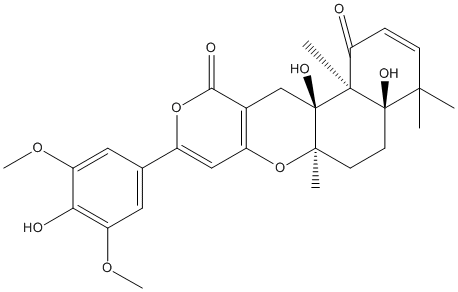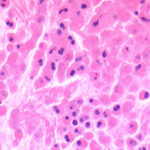Date: 26 November 2013
Secondary metabolites, structure diagram: Trivial name – territrem C
Copyright: n/a
Notes:
Species: A. terreusSystematic name: 4H,11H-Naphtho(2,1-b)pyrano(3,4-e)pyran-1,11(5H)-dione, 4a,6,6a,12,12a,12b-hexahydro-4a,12a-dihydroxy-9-(4-hydroxy-3,5-dimethoxyphenyl)-4,4,6a,12b-tetramethyl-, (4aR-(4a-alpha,6a-beta,12a-alpha,12b-beta))-Molecular formulae: C28H32O9Molecular weight: 512.548Chemical abstracts number: 89020-33-7Selected references: Ling KH, Yang CK, Peng FT. Territrems, tremorgenic mycotoxins of Aspergillus terreus. Appl Environ Microbiol. 1979 Mar;37(3):355-7. Ling KH, Liou HH, Yang CM, Yang CK. Related Articles, Links Isolation, chemical structure, acute toxicity, and some physicochemical properties of territrem C from Aspergillus terreus. Appl Environ Microbiol. 1984 Jan;47(1):98-100. Chen JW, Ling KH. Territrems: Naturally Occurring Specific Irreversible Inhibitors of Acetylcholinesterase. J Biomed Sci. 1996 Jan;3(1):54-58.Toxicity: mouse LD50 intraperitoneal 6280ug/kg (6.28mg/kg) Applied and Environmental Microbiology. Vol. 47, Pg. 98, 1984.
Images library
-
Title
Legend
-
Embolisation 7 – patient WC. Angiogram of the lateral thoracic artery on subtraction film showing grossly abnormal vasculature inferiorly shunting along several anterior intercostal arteries to the internal mammary artery. In addition a pseudoaneurysm is shown.
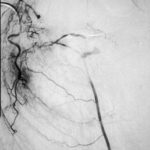
-
Embolisation 6 – patient WC. Catheter tip in the lateral thoracic artery on screening film.

-
Grocott (silver) stain showing branching septate hyphae fairly typical of Aspergillus in mucus. The apparent right angle branching is unusual.
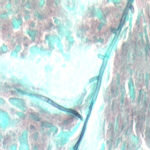
-
Bronchial mucosa under H & E stain showing numerous eosinophils deep to the mucosa, and mucus in the lumen of the bronchiole.
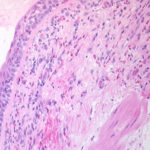
-
Grocott (silver) stain showing branching septate hyphae fairly typical of Aspergillus in mucus. The apparent right angle branching is unusual.

-
Severe kyphoscoliosis caused by greater than 40 years of prednisolone for ABPA and asthma.

-
These pictures show remarkable curvature of the spine as a result of collapse of the vertebral bodies of the thoracic vertebrae. This is a gross example of steroid-induced osteoporosis. The dose was not large in the last 10 years, typically 5-10mg daily, but multiple high dose courses and slow tapering lead to this outcome.
Her corticosteroid warning card is also demonstrated, as additional steroids are required for any significant illness or surgery, as her adrenal glands had completely atrophied.
Kindly supplied by Prof David Denning, South Manchester University Hospitals NHS Trust, Manchester UK
(© Fungal Research Trust)
 ,
,  ,
, 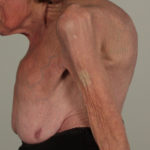 ,
,  ,
, 

